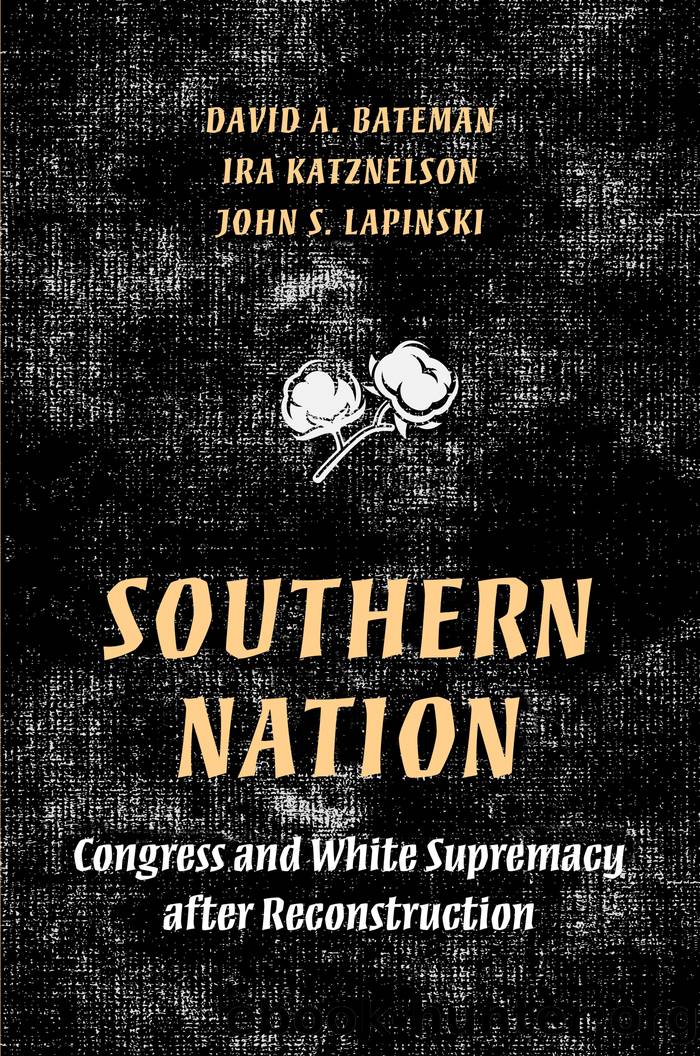Southern Nation by unknow

Author:unknow
Language: eng
Format: epub
ISBN: 9780691126494
Publisher: PrincetonUP
Published: 2018-07-15T05:00:00+00:00
The Rise of Southern Influence
The twentieth century began with considerable momentum in the South for progressive reforms, though it was more of a tendency than a consensus view. Three decades later, there was still support for federal policy activism in the region, but also an invigorated statesâ rights conservatism, represented by southern Democrats as well as a considerable number of Republicans elected in 1928. Whether southerners wanted to expand the scope of federal activity or roll it back, however, their ability to do so varied with changes in the institutional environment and their own success at cultivating bipartisan coalitions. Just as southern policy priorities varied across the region and across time, so did their ability to influence the content of national policy.
We have found it useful to subdivide the Progressive era in national politics into two periods, ranging roughly from 1900 to 1916 and from 1917 to 1930. This unusual periodization is guided by attention to the dynamics of southern Democratic lawmaking, in terms of both the substantive positions taken by the regionâs legislators and their prospect for shaping public policy and the means by which they could do so. The first period can be characterized as one of slowly cresting momentum: after a decade in which southerners had been largely excluded from power and progressive priorities were usually defeated or substantially reworked, newly elected Democratic majorities were now rapidly able to enact most of the items on the Southâs legislative agenda. It is a story of rising action as southern Democrats largely maintained their cohesion on a set of shared priorities, and it culminates in reforms that were progressive in economic terms while further entrenching white supremacy in national policy.
The second period began around the time of the policy enactments that accompanied Wilsonâs preparedness program and Americaâs entry into the war, and it concludes with the catastrophic crisis that global capitalism faced after 1929. The story of this period picks up at the height of Wilsonian progressivism. If in the early years of Wilsonâs administration the South had largely been able to maintain cohesion on core priorities, working out compromises and accommodations as needed but otherwise shepherding through Congress a reform program that reflected the regionâs long-standing demands, in his second term party unity collapsed, the caucus ceased to serve as an effective coordinating mechanism, and a divided South entered into shifting coalitions with progressive and conservative Republicans. The pattern of politics that followed in the 1920s bore more similarities to Wilsonâs second term in its unstable legislative coalitions than to the 1900s or early Wilson years. The story is of the dissipation of progressive momentum, the fragmentation of Democratic and southern unity, and the rise to prominence of a different pattern of congressional lawmaking that was organized around issue-specific legislative coalitions as much as around the majority partyâs agenda. Southern lawmaking in this period looked more like interest-group politics, without the unifying themes of progressive reform or the imperatives of supporting the presidential administration that earlier had induced regional cohesion.
Download
This site does not store any files on its server. We only index and link to content provided by other sites. Please contact the content providers to delete copyright contents if any and email us, we'll remove relevant links or contents immediately.
| Africa | Americas |
| Arctic & Antarctica | Asia |
| Australia & Oceania | Europe |
| Middle East | Russia |
| United States | World |
| Ancient Civilizations | Military |
| Historical Study & Educational Resources |
The Bomber Mafia by Malcolm Gladwell(1180)
Submerged Prehistory by Benjamin Jonathan; & Clive Bonsall & Catriona Pickard & Anders Fischer(1162)
Facing the Mountain by Daniel James Brown(1131)
The Dawn of Everything by David Graeber & David Wengrow(1105)
The Way of Fire and Ice: The Living Tradition of Norse Paganism by Ryan Smith(1032)
Wandering in Strange Lands by Morgan Jerkins(1014)
Driving While Brown: Sheriff Joe Arpaio Versus the Latino Resistance by Terry Greene Sterling & Jude Joffe-Block(1002)
Tip Top by Bill James(1002)
Evil Geniuses: The Unmaking of America: A Recent History by Kurt Andersen(999)
Red Roulette : An Insider's Story of Wealth, Power, Corruption, and Vengeance in Today's China (9781982156176) by Shum Desmond(997)
F*cking History by The Captain(966)
It Was All a Lie by Stuart Stevens;(940)
White House Inc. by Dan Alexander(904)
Evil Geniuses by Kurt Andersen(901)
Treasure Islands: Tax Havens and the Men who Stole the World by Nicholas Shaxson(879)
American Dreams by Unknown(857)
American Kompromat by Craig Unger(847)
The Fifteen Biggest Lies about the Economy: And Everything Else the Right Doesn't Want You to Know about Taxes, Jobs, and Corporate America by Joshua Holland(816)
The First Conspiracy by Brad Meltzer & Josh Mensch(811)
